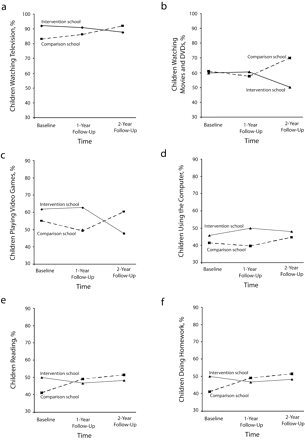Safe play spaces to promote physical activity in inner-city children: results from a pilot study of an environmental intervention
- PMID: 17666701
- PMCID: PMC1963283
- DOI: 10.2105/AJPH.2006.092692
Safe play spaces to promote physical activity in inner-city children: results from a pilot study of an environmental intervention
Abstract
Objectives: We evaluated the effect of providing a safe play space on the physical activity level of inner-city schoolchildren.
Methods: In 1 of 2 matched neighborhoods, we opened a schoolyard and provided attendants to ensure children's safety. Over the next 2 years we directly observed the number of children and their physical activity levels in the school-yard, as well as in the surrounding intervention and comparison neighborhoods. We also surveyed children in the schools in the intervention and comparison neighborhoods regarding sedentary activities.
Results: After the schoolyard was opened, a mean of 71.4 children used it on weekdays and 25.8 used it on weekends during the school year. When observed, 66% of these children were physically active. The number of children who were outdoors and physically active was 84% higher in the intervention neighborhood than the comparison neighborhood. Survey results showed that children in the intervention school reported declines relative to the children in the comparison school in watching television, watching movies and DVDs, and playing video games on weekdays.
Conclusion: When children were provided with a safe play space, we observed a relative increase in their physical activity. Provision of safe play spaces holds promise as a simple replicable intervention.
Figures

References
-
- Ogden CL, Carroll MD, Curtin LR, McDowell MA, Tabak CJ, Flegal KM. Prevalence of overweight and obesity in the United States, 1999–2004. JAMA. 2006; 295:1549–1555. - PubMed
-
- Physical Activity and Health: A Report of the Surgeon General. Atlanta, Ga: Centers for Disease Control and Prevention; 1996.
-
- Berkey CS, Rockett HR, Field AE, et al. Activity, dietary intake, and weight changes in a longitudinal study of preadolescent and adolescent boys and girls. Pediatrics. 2000;105:E56. - PubMed
-
- Centers for Disease Control and Prevention. Physical activity levels among children aged 9–13 years—United States, 2002. MMWR Morb Mortal Wkly Rep. 2003;52 (33):785–788. - PubMed
-
- Gordon-Larsen P, McMurray RG, Popkin BM. Determinants of adolescent physical activity and inactivity patterns. Pediatrics. 2000;105:E83. - PubMed
Publication types
MeSH terms
Grants and funding
LinkOut - more resources
Full Text Sources
Medical

